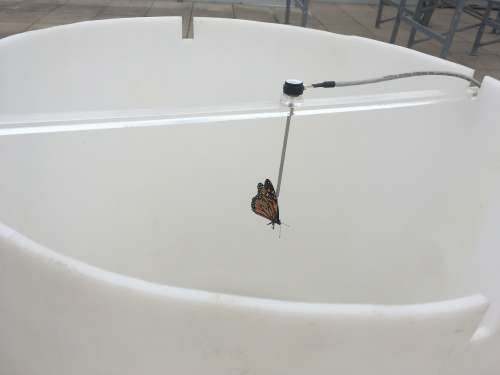Share this article
Even captive monarchs migrate south
Eastern monarch butterflies kept in captivity still migrate south when they’re released. That could be good news for butterfly-rearing hobbyists and classrooms that raise monarchs as a learning opportunity.
Researchers made this discovery as a bit of an accident. They were studying if butterflies feeding on milkweed treated with neonicotinoids, a common pesticide, impacts the declining butterflies that migrate to Mexico during the fall. Using a flight stimulator funnel—an open funnel where they measured the butterflies’ directionality—and radio tracking, they found that the pesticide didn’t seem to affect the butterflies’ migration. But they did notice differences in the migration of the butterflies when they used the two different methods.
Past research on captive monarchs (Danaus plexippus) only used the flight simulators. “In the funnel, they oriented all over the place,” said Ryan Norris, a professor in the Department of Integrated Biology at the University of Guelph.
Norris was the senior author of a recent study published in Conservation Physiology led by PhD student Alana Wilcox, which compared the flight simulation funnels with radio tracking. “In the past in my lab using the same funnel on wild monarchs, they showed clear directionality,” he said. “When we got radio tracking results back for this study, they all went south or southeast.”

A monarch inside a flight simulator. Credit: Ryan Wilcox
The findings suggest that monarchs may need 24 hours or more to recalibrate their direction in the wild, Norris said. Past research has shown that songbirds like Swainson’s thrushes (Catharus ustulatus) need a full day to recalibrate their magnetic senses after those senses were disturbed. While monarchs aren’t using the magnetic field, “it might be something when they’re in captivity, they may not get that proper sunlight orientation,” Norris said. “But it seems once they go are released in the wild, after 24 hours or more, they go south.”
The results suggest that rearing monarchs indoors, which many people do in the U.S. and Canada, can offer benefits to the butterflies, Norris said, but it also raises some concerns. While raising monarchs protects the butterflies from predators, the close quarters can increase the chances of parasites.
“But the other big plus side that’s not quantifiable is the education part of it,” he said. “It goes beyond monarchs in a sense. It teaches people about the butterfly lifecycle and how they transform from a chrysalis to an adult. It’s pretty amazing.”
Header Image: Researchers fit monarch butterflies with tracking devices, like the one pictured here. Credit: Alana Wilcox








